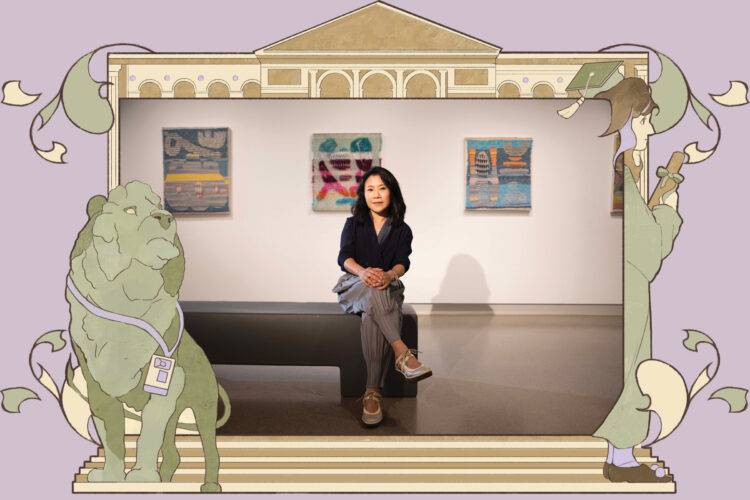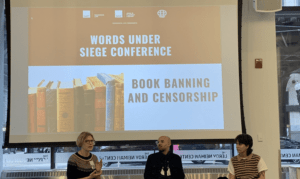
The interview this article transcribes was conducted in the Fall semester of 2024. An abbreviated version went into the 2024 December print issue. The full version of that article is below.
Do you feel that having an artistic background will help connect you to the SAIC community and help you understand the needs of the student body?
Jiseon Lee Isbara: Yes, I’m going to say yes. Although, you know, if I’m going to be connected to the student body, it’s something the students have to tell me. I can only tell you my experience as an artist as well, and why I think it’s helpful to do my job, right? So, I went to art school. was a faculty in the Fibers Department at my previous, previous, previous school. And also, I led the school as a provost and president. And while I was doing so, I was also practicing my art as well. So, I was never separated from art practice that students were doing or faculty were doing. That means there is always common ground for me to discuss or dialogue about with my colleagues and students. In that sense, I think it’s very helpful There are also topics and contemporary kind of ideas and pedagogy and practice and always changing in art and design ecology. So, understanding that as a practitioner, I think, is very important as well.
Right now, it’s like a weird time for campuses all over the U.S. So, what do you think is SAIC’s greatest need right now? And how do you plan on meeting those?
JLI: Well, I came here in U.S. in 1999. That was a weird time, too. So, I think there were always some challenges in every moment of my career. There was the pandemic as well that we had to deal with. There was some racial reckoning as well. And when I started to teach, there was 9/11. So, there are always difficult times that I had to manage as a faculty chair or dean or president or whatever it is. There were always moments that we had to deal with. So, the timing itself doesn’t isn’t necessarily in my mind so much. But I’m coming in here as a newcomer, right?
JLI: So, what I’m trying to do right now is to meet with a lot of different colleagues and students and alumni and also patrons out there to understand the strength that makes the school shine. And also understand the challenges that students or other colleagues feel. I will have to learn that first before I assess and identify anything that needs to be strengthened or enhanced or fixed. So, I’m just in the process of learning that.
As a follow-up, is there anything that has stood out so far in terms of needs?
JLI: I’m still learning a lot from many folks. Generally speaking, I think [staff and faculty] here are amazingly mission-driven. And when we say mission-driven, that feels dry, okay? So, what I feel is that they are here for the reason that they are here. They all see themselves as teachers. They see themselves as mentors for students. They care about the environment that they create for students’ education. So, everyone understands their role and how they want to contribute to the students’ education.
JLI: Second thing, I think students talk a lot about their academic experiences. You know, their classroom experiences, resources that they need, kind of critique experiences, space, studio, and things like that. So, I hear a lot about those academic experiences and also student activities experiences. They wish to be supported and thought of differently.
JLI: Faculty’s end, you know, is also about research that they are doing and kind of support or aspiration that they have. And also pedagogical discussions they’re having for students.I hear that a lot too.
Could you help give a little bit of clarity or light on how the role of the president fits into the administrative structure at SAIC?
JLI: So, philosophically speaking, as I mentioned before, I was faculty, chair, dean, provost, and now president for the shortest time. I don’t believe my role has changed much fundamentally. My role is to deliver the curriculum and services for our students wherever I am.
JLI: When you’re a faculty, you focus on what you do in the classroom. When you’re a chair, you focus on what is happening in the department. When you’re dean and provost, you focus on what is happening in larger educational kind of programs, and then other services are added to their oversight. So, that’s kind of what happens. So, do I feel that my fundamental role as an educator has changed? I don’t think so, but my responsibilities got larger and larger during this time. So, that’s philosophically how I see myself as an educator.
JLI: Organizationally, if you’re talking about how the school operational organization is formed, there is a board. There is a board of trustees and a board of governors. The board of governors only exists for the school, and they do not have fiduciary responsibilities. They are volunteers from the community. So, they actually donate to the school, financially, but also donate their talents and network and knowledge and experience.
JLI: There is a president’s office. (9:14) A president reports to the board, okay? And then there are multiple vice presidents who are responsible for their academic area, student services area, IT, facility area, and security area. All these things that you see on campus, there are persons on top who are responsible to manage and oversee those areas. And there are a lot of directors and other managerial staff, of course, as well.
After the encampment on May 4th where SAIC community members, including professors and students, were arrested, many felt a loss of trust between SAIC and its community. How is your administration planning to repair that and bridge the gap between the students and the school?
JLI: I can imagine, from even outside at the time, how difficult a situation it is for everyone in the school. I could imagine how challenging it was for the SAC community of people. Everyone, including students, faculty and staff, administrators, everyone, even people in the city around this area, probably had hard times.
JLI: Right now, as I mentioned before because I just came in, I’m trying to look to the future. I’ve been saying this and I also put it in my email when I request a meeting with a lot of folks. It’s my goal this year to meet with as many members of the school as possible, as my calendar allows. And the reason I’m doing it is to understand the culture of the school and what people think, where we are as a community, what their aspirations are. So that’s kind of what I’m doing right now. There’s one of me and there are 5,000 of you, so it’s definitely taking a lot of time.
JLI: Urgency is something that I think about when I’m doing anything and everything. But thoughtfulness is another thing that I’m thinking about when I’m doing anything and everything.
So I need to find a balance. don’t want to jump into something when I don’t understand what that is.
How will you and your administration assess the effectiveness of our current financial aid programs? And what improvements or changes are you considering to meet students’ financial needs?
JLI: When I was interviewed for the school, there were things that I learned from the school. And I think accessibility and affordability were two things that the school was systematically focusing on.
JLI: So I believe that we kept our tuition increase lower than the national average. I believe we also redid the credit structure. I believe that the institutional scholarship amount as a budget also increased in the last few years. So I heard that the school put an effort to systematically keep the tuition as low as possible. But that doesn’t mean that it’s low. […] I think there was a systematic effort to keep it as low as possible. JLI: And I also know that almost 90% of our students get financial aid or scholarship, institutional scholarship. Our tuition as a net or as a total does not pay for 100% of our operational budget. So that’s why also the fundraising for scholarships and endowments kicks in to supplement the needs for the scholarship endowment and other kinds of funded programs that we offer for students as well. So those efforts will continue to happen, and I will need to learn a little bit more what are the specific areas that we need to focus on to help our students to graduate with a degree. Because there are definitely groups of students whose graduation rate is probably lower than the other groups, for example. So we need to identify a kind of focused group of students who might need a little bit more support to continue their education.
Reflecting on the conversation we’ve had and the conversations that you’ve had with students so far, what do you think makes you a good fit for SAIC right now?JLI: I’m a first-generation immigrant who came here from South Korea in the late ’90s. So fitting to something is not necessarily what I’m thinking about as an individual, as an artist, or as an educator. As just a person who goes to a new job or new city or new state, I always think about what I’m going to learn from where I join, from the people that I join. Or what I’m going to share, you know, in terms of my lived experience and professional experiences and how we can make a synergy out of it.
What are you most looking forward to about the school year?
JLI: Meeting a lot of people. I’m a very focused person. I have one goal. And I’m not saying it as a joke. It’s been very helpful for me to meet a lot of different folks from different corners of the college. And what they share is teaching me a lot about what the school is about.
JLI: Because I always knew the school from outside. I was an artist. So I showed with the faculty members here in exhibitions. I curated their work into exhibitions myself. I worked with your alumni. I invited them for the visiting artist opportunities. So I felt like I knew the school from outside, what the school represents, from the work the school produced. Now I came in. There are 5,000 people here. And generally speaking, meeting with them gives me a lot of different ideas about who we are. That is nuanced. It’s not written. So I think it’s actually very, very helpful. And a lot of times what I realize also is that we all think that we want this X. Therefore, a lot of folks also think that there is one way to get to X. But generally, if I meet with 50 people, 50 people talk about 50 different ways to get to X. It’s very helpful to understand kind of common theme and why it’s important to them.
JLI: It doesn’t mean that I’m going to say I agree with all of them, right? might question it myself. I also think about some things critically or some things very sympathetically. But all of that is helpful for me. So that’s my goal. That’s what I’m looking forward to.







